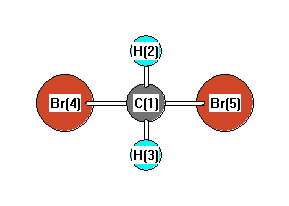Geometric Data

Point Group C2v
Internal coordinates
distances (r) in Å, angles (a) in degrees, dihedrals (d) in degrees
These cartesians were determined using some assumed coordinate values.
Cartesians
| Atom |
x (Å) |
y (Å) |
z (Å) |
| C1 |
0.0000 |
0.0000 |
0.9391 |
| H2 |
-0.8887 |
0.0000 |
1.5510 |
| H3 |
0.8887 |
0.0000 |
1.5510 |
| Br4 |
0.0000 |
1.6043 |
-0.1248 |
| Br5 |
0.0000 |
-1.6043 |
-0.1248 |
Atom - Atom Distances 
Distances in Å
| |
C1 |
H2 |
H3 |
Br4 |
Br5 |
| C1 |
|
1.0790 | 1.0790 | 1.9250 | 1.9250 |
| H2 |
1.0790 |
|
1.7774 | 2.4843 | 2.4843 |
| H3 |
1.0790 | 1.7774 |
|
2.4843 | 2.4843 |
| Br4 |
1.9250 | 2.4843 | 2.4843 |
|
3.2086 |
| Br5 |
1.9250 | 2.4843 | 2.4843 | 3.2086 |
|
Calculated geometries
for CH
2Br
2 (dibromomethane).
Experimental Bond Angles (degrees) from cartesians 
| atom1 |
atom2 |
atom3 |
angle |
|
atom1 |
atom2 |
atom3 |
angle |
| H2 |
C1 |
H3 |
110.900 |
|
H2 |
C1 |
Br4 |
108.266 |
| H2 |
C1 |
Br5 |
108.266 |
|
H3 |
C1 |
Br4 |
108.266 |
| H3 |
C1 |
Br5 |
108.266 |
|
Br4 |
C1 |
Br5 |
112.900 |
Bond descriptions
Examples: C-C single bond, C=C, double bond, C#C triple bond, C:C aromatic bond
| Bond Type |
Count |
| H-C |
2 |
| C-Br |
2 |
Connectivity
| Atom 1 |
Atom 2 |
| C1 |
H2 |
| C1 |
H3 |
| C1 |
Br4 |
| C1 |
Br5 |












